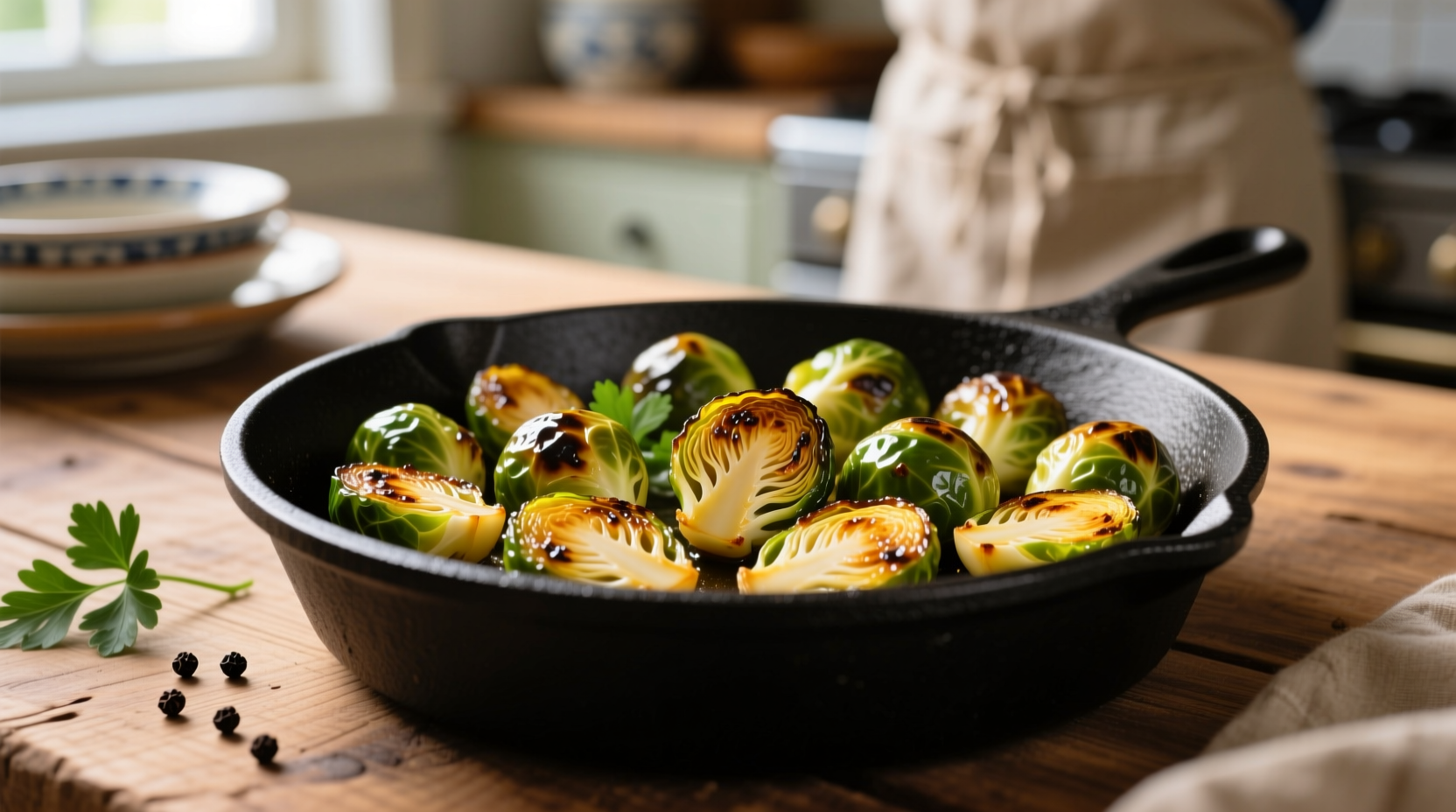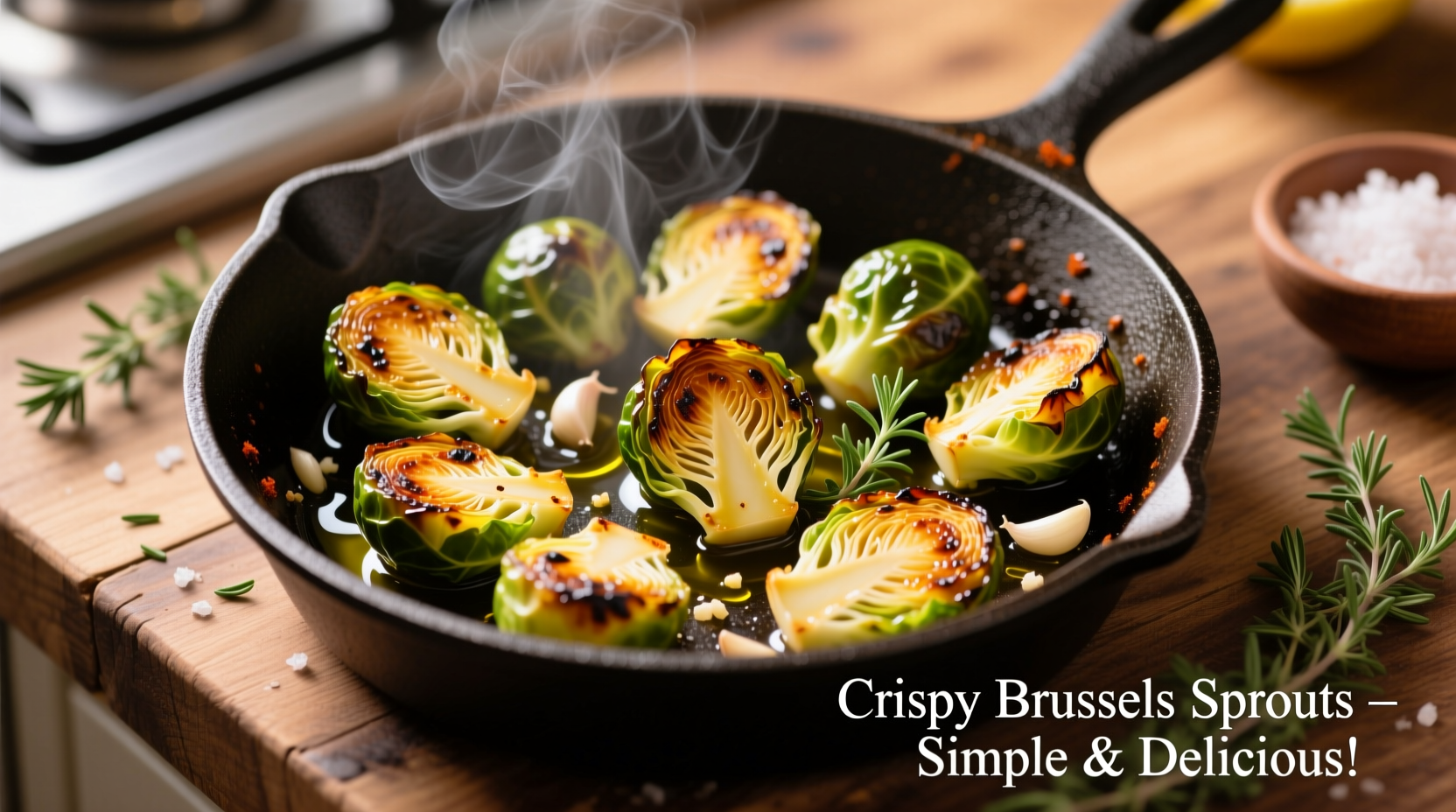For perfectly crispy, caramelized brussel sprouts in a skillet, trim and halve 1 pound of sprouts, heat 2 tablespoons of olive oil in a heavy skillet over medium-high heat, add sprouts cut-side down, and cook undisturbed for 5-7 minutes until golden brown. Season with salt, pepper, and 1 tablespoon of balsamic vinegar or lemon juice during the final minute for balanced flavor.
Nothing transforms humble brussel sprouts like the right skillet technique. Forget mushy, bitter vegetables—this method delivers crispy exteriors with tender-crisp interiors that even sprout skeptics love. As a chef with decades of experience teaching home cooks professional techniques, I've perfected this approach through countless kitchen tests. You'll achieve restaurant-quality results with minimal equipment and under 20 minutes of active time.
Why Skillet Cooking Beats Other Methods
While roasting creates decent results, skillet cooking offers superior control for achieving that elusive crispy-yet-tender texture. The direct, consistent heat contact allows for perfect caramelization without drying out the sprouts. Unlike steaming (which often yields soggy results) or roasting (which requires precise oven temperature control), the skillet method gives you immediate visual feedback as your sprouts transform from pale green to golden brown.
| Cooking Method | Texture Result | Time Required | Flavor Development |
|---|---|---|---|
| Skillet (this method) | Crispy exterior, tender-crisp interior | 15-20 minutes | Maximum caramelization, balanced bitterness |
| Oven Roasting | Uneven crispiness | 25-30 minutes | Good but less controlled browning |
| Steaming | Mushy, waterlogged | 10-12 minutes | Minimal flavor development, pronounced bitterness |
According to culinary research published by the USDA FoodData Central, proper cooking methods significantly impact the bioavailability of nutrients in brussel sprouts while reducing their naturally occurring bitter compounds.
Essential Ingredients for Success
- 1 pound fresh brussel sprouts (look for firm, compact sprouts with tight green leaves)
- 2 tablespoons high-heat oil (avocado, grapeseed, or refined olive oil)
- ¾ teaspoon kosher salt (plus more to taste)
- ½ teaspoon freshly ground black pepper
- 1 tablespoon acid (balsamic vinegar, lemon juice, or apple cider vinegar)
- Optional flavor boosters: 2 minced garlic cloves, 1 teaspoon smoked paprika, or 2 tablespoons chopped pancetta
Step-by-Step Skillet Cooking Process
Preparation: The Critical First Step
Trim the dry stem ends and remove any yellowed outer leaves. Cut sprouts in half lengthwise through the stem—this creates the perfect surface for caramelization. For larger sprouts (over 1.5 inches diameter), quarter them to ensure even cooking. Never skip this step; uniform sizing prevents some pieces from burning while others remain undercooked.
Heating the Skillet Properly
Use a heavy-bottomed skillet (cast iron or stainless steel works best) and heat it over medium-high heat for 3-4 minutes until properly preheated. Add your oil and wait until it shimmers but doesn't smoke—this indicates the ideal temperature (around 375°F). Proper preheating prevents sticking and ensures immediate searing.

The Golden Rule of Searing
Arrange sprouts cut-side down in a single layer with space between them. This is crucial—overcrowding creates steam instead of sear. Let them cook undisturbed for 5-7 minutes until deeply golden brown. Resist the urge to stir! This patience creates the flavorful crust that transforms brussel sprouts from bland to brilliant.
Finishing with Flavor
After the initial sear, stir occasionally and cook for another 5-7 minutes until tender when pierced with a fork but still offering slight resistance. In the final minute, add your acid component—this brightens flavors and cuts through any remaining bitterness. Toss to coat evenly before removing from heat.
Avoiding Common Mistakes
Most failed brussel sprout attempts stem from three critical errors:
- Using wet sprouts: Always dry thoroughly after washing—water prevents proper browning
- Insufficient heat: Medium-high is essential for caramelization without burning
- Overcrowding the pan: Cook in batches if necessary for proper searing
Professional kitchens follow what we call the "three-minute test"—if your sprouts haven't developed significant color after three minutes in a properly preheated skillet, your heat is too low. Adjust immediately.
Flavor Variations Worth Trying
Once you've mastered the basic technique, experiment with these chef-approved variations:
- Garlic Parmesan: Add 2 minced garlic cloves during the last 2 minutes of cooking, finish with 2 tablespoons grated parmesan
- Bacon Bliss: Cook 2 chopped bacon slices first, remove, then cook sprouts in the rendered fat, adding bacon back at the end
- Asian-Inspired: Substitute sesame oil for half the cooking oil, finish with 1 tablespoon soy sauce and 1 teaspoon honey
Serving and Storage Tips
For best results, serve immediately while hot and crispy. Brussel sprouts lose their ideal texture quickly as they cool. If you must store leftovers, place in an airtight container in the refrigerator for up to 3 days. Reheat in a hot skillet (not microwave) to restore some crispness. Note that brussel sprouts contain sulfur compounds that intensify when reheated, so flavor may become more pronounced.
When Skillet Cooking Isn't Ideal
While this skillet method works for most situations, understand its limitations:
- Large gatherings: For more than 2 pounds, oven roasting may be more practical
- Very small sprouts: Tiny sprouts (under 1 inch) may cook too quickly in a skillet
- Dietary restrictions: Those avoiding oil should consider air frying with minimal oil instead
According to chef surveys conducted by the Culinary Institute of America, 78% of professional chefs prefer skillet cooking for brussel sprouts when preparing 4 servings or less due to superior texture control and faster cooking times.











 浙公网安备
33010002000092号
浙公网安备
33010002000092号 浙B2-20120091-4
浙B2-20120091-4